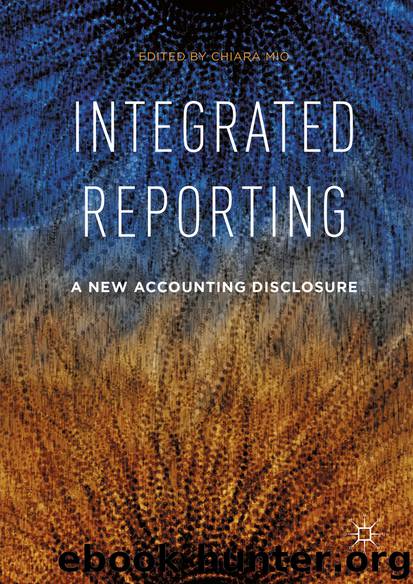Integrated Reporting by Chiara Mio

Author:Chiara Mio
Language: eng
Format: epub
Publisher: Palgrave Macmillan UK, London
Introduction
According to the International Federation of Accountants (IFAC) (2014), environmental, social and governance information is increasingly being used by investors to understand an organization’s key ESG factors and how they impact overall performance over a longer time span. In this context, Integrated Reporting (IR) may play a central role as a vehicle of non-financial information that is often important in assessing companies’ future long-term performance. The International Integrated Reporting Council (IIRC) seems to strongly believe in such a role for IR, as it defined long-term investors as one of the main audiences of IR (IIRC 2013) and has launched its Investor Network.
There are two main reasons at the base of the relationship between IR and institutional investors.
First, IR may help reduce the information asymmetries between managers and investors. IR aims at providing material information crucial for investors to understand the future ability of a corporation to generate value. Lower levels of information asymmetries in turn facilitate and reduce the cost of access to finance for corporations (see Hubbard 1998; Merton 1987) and lower the cost of monitoring and activism (see Healy and Palepu 2001).
Second, IR may increase (or mark) a reporting company’s long-term orientation. Internally, IR helps managers collect information and data that are useful in orienting them toward the long term. For instance, assessing the issues that will materially affect the future performance of a corporation is a central activity both for the purposes of IR and for effective long-term management. Externally, IR signals the long-term and sustainability orientation of a company to institutional investors. As argued by Knauer and Serafeim (2014), “reporting a company’s strategy, external environment, performance and prospects in an integrated way has the potential to showcase management’s commitment to operating in a sustainable and responsible way”.
This chapter investigates the interrelations between IR (or more specifically: the participation in the IIRC Pilot Program) and institutional investors. First, it hypothesizes that institutional investors pushed their companies to join the IIRC Pilot Program. This form of institutional investor activism is justified by the expected benefits for the companies in joining the IIRC Pilot Program. Second, it hypothesizes that companies that joined the IIRC Pilot Program are able to attract institutional investors to a higher extent, because of lower information asymmetries and better long-term orientation.
Our preliminary empirical results show that there are no statistically significant effects of IR on institutional investor shareholdings and vice versa. As will be more extensively discussed below, one possible explanation for our results is that institutional investors are not yet fully aware of or persuaded by the benefits of IR. This evidence confers a central role to the IIRC investor network, which aims to enable investors to provide their perspective on corporate reporting.
Further research is needed in order to assess the impact of IR, not only on institutional investor shareholding but also on the specific characteristics of such shareholding. It may be that IR, on the international level, increases the shares of long term-oriented investors, consistently with what was found by Serafeim (2015) for the US context.
Download
This site does not store any files on its server. We only index and link to content provided by other sites. Please contact the content providers to delete copyright contents if any and email us, we'll remove relevant links or contents immediately.
Zero to IPO: Over $1 Trillion of Actionable Advice from the World's Most Successful Entrepreneurs by Frederic Kerrest(4395)
Machine Learning at Scale with H2O by Gregory Keys | David Whiting(4256)
Never by Ken Follett(3874)
Harry Potter and the Goblet Of Fire by J.K. Rowling(3800)
Ogilvy on Advertising by David Ogilvy(3546)
Shadow of Night by Deborah Harkness(3322)
The Man Who Died Twice by Richard Osman(3035)
Book of Life by Deborah Harkness(2889)
Will by Will Smith(2864)
The Tipping Point by Malcolm Gladwell(2860)
0041152001443424520 .pdf by Unknown(2810)
My Brilliant Friend by Elena Ferrante(2788)
How Proust Can Change Your Life by Alain De Botton(2767)
Purple Hibiscus by Chimamanda Ngozi Adichie(2725)
How to Pay Zero Taxes, 2018 by Jeff A. Schnepper(2621)
Hooked: A Dark, Contemporary Romance (Never After Series) by Emily McIntire(2526)
Rationality by Steven Pinker(2321)
Borders by unknow(2278)
Can't Hurt Me: Master Your Mind and Defy the Odds - Clean Edition by David Goggins(2266)
